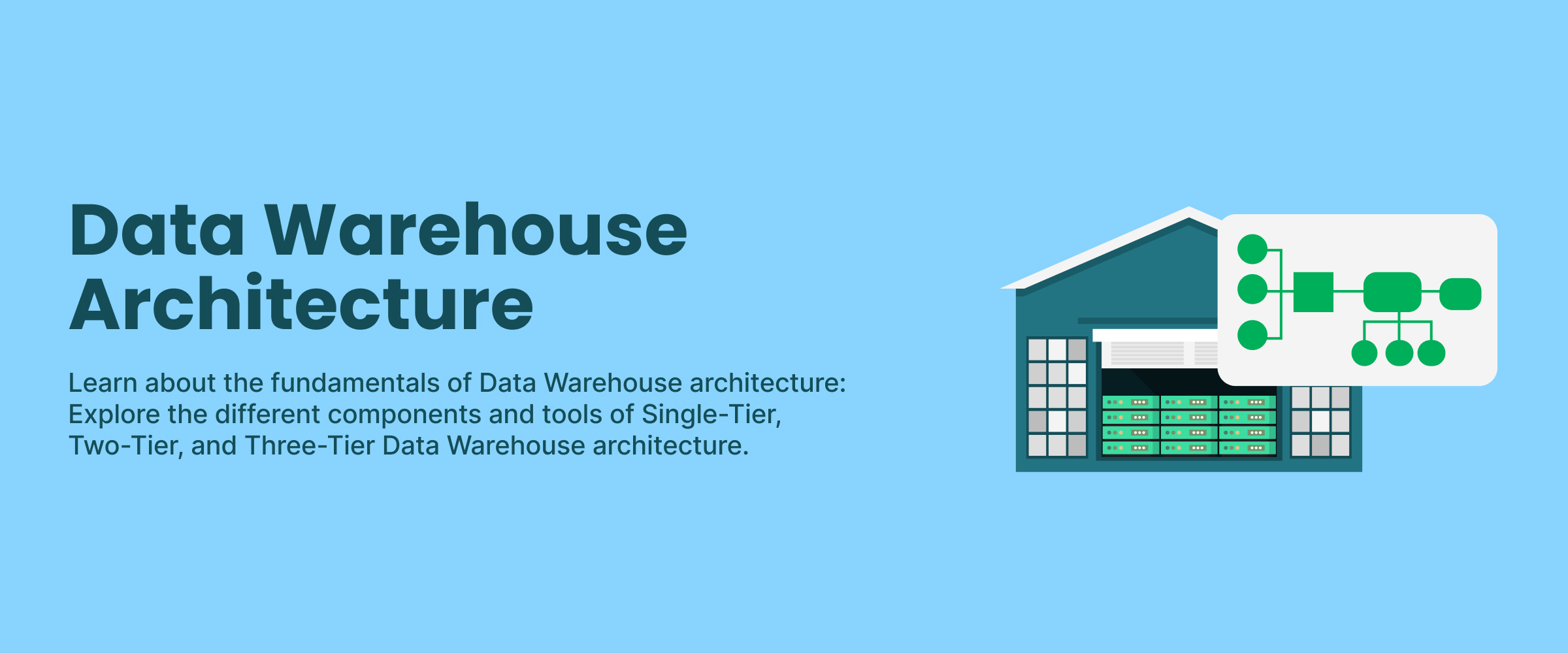Data Warehouse Architecture – Features, Types, & Components
The market for data warehousing is booming in a big way, with the value of the industry set to skyrocket from $21.18 billion in 2019 to an astounding $51.18 billion by 2028. This increase highlights how important data warehousing is when it comes to creating effective strategies for the future.
In this blog post, we look into what makes data warehousing a vital component of modern business strategies. We will go on to explain data warehouse architecture, the three-tier architecture of data warehouse, and everything you need to know about data warehouse architecture.
What is a Data Warehouse?
A data warehouse is a system used to store and manage large amounts of gathered information. It can come from various sources all in one place for an organization’s use. Data warehouses give companies access to analytical tools that help with decision-making by providing things like reports and the ability to analyze the data further.
You can take this data science course to get a more comprehensive understanding of data warehouse and its components.
What is Data Warehouse Architecture?
Data warehouse architecture is a framework that lays out the design of data warehouses. It helps manage and process raw data so it can be converted into useful and understandable information for businesses to use in making decisions. The structure provides an overview of how all parts work together. You can also take a look at the roadmap to starting a data science career.
Data warehouse architecture is based on three main types of models. These include single-tier, two-tier, and three-tier architecture. Let’s get a better understanding of each of these models in detail below.
Single-Tier Architecture
The goal of a single layer is to make data storage simpler and less repetitive. This approach isn’t commonly used in the real world, since it condenses all your information into one set. This can be helpful for eliminating redundancies but doesn’t work well if you need lots of different types or streams of information.
Two-Tier Architecture
The two-tier architecture is a great data warehouse setup for small organizations that don’t require scalability. In a two-tier data warehouse model, the tangible data sources are kept separate from the actual warehouse.
This structure is commonly used by small organizations that use only one server as their “data mart”. While this system can be efficient in terms of storage and organization, it cannot handle large numbers of users nor does it have scalability capabilities.
Three-Tier Architecture
Many organizations choose to use the three-tier architecture when creating a data warehouse system. This design helps avoid some of the connection issues that can happen with two-tier architectures. It is divided into three tiers, the top, middle, and bottom.
- Bottom Tier: The bottom tier of a data warehouse is typically comprised of a relational database system that stores cleansed, transformed, and loaded data.
- Middle Tier: At the middle tier level, an Online Analytical Processing (OLAP) server serves as a mediator between the end user and the database. This can be implemented using either ROLAP or MOLAP models.
- Top-Tier: Sitting on top are front-end client tools that provide users access to query, report, manage queries, and analyze the output data from warehouse systems.
Get a confirmed ₹35,000 total stipend with our data science course with placement guarantee.
Attributes of Data Warehouse Architectures
The characteristics of a data warehouse system include the following.
- Diverse Responsibilities: Analytical processes and transactional activities should be kept as independent from each other as possible.
- Flexibility: Systems must incorporate software and hardware design that will allow them to suitably manage increased user demand and larger volumes of data over time without any major reconfiguration or redesign by administrators.
- Expandable Characteristics: The architecture needs to account for expansions or new operations/technologies that may need to be included in the future while still keeping the system stable during alterations.
- Establishing Security: Appropriate measures must be taken to guarantee the protection of confidential information kept in these warehouses when allowing access.
- Manageability: A system should be designed so it can easily be managed on a daily basis with minimal effort and disruption for routine maintenance tasks.
Components of Data Warehouse Architecture
In this section, we will gain an understanding of the data warehouse components as well as its architecture with a visual representation, displayed in the form of a diagram.
Data Warehouse Database
Data warehouses typically rely on relational database management systems (RDBMS) to store and process data. However, RDBMS technology can be slow at tasks like complex queries or multiple table joins, which is why alternate techniques are often used, such as:
- Running databases in parallel for performance gains
- Creating faster index structures for quicker access to information
- Using MDDBS like Oracle’s Essbase to surpass the limitations of the traditional model
Sourcing, Acquisition, Clean-up and Transformation Tools (ETL)
ETL tools make it easier to organize data by collecting details from multiple sources, cleaning them up, and transforming them into a convenient format. They can take care of anonymization for security requirements, filter irrelevant content, unify terminology across different documents, create summaries in an easy-to-understand language as well as fill any empty spaces or remove duplicates.
These tools can create automated tasks, such as cron jobs, background jobs, Cobol programs, and shell scripts that keep the data in a data warehouse up to date. The only challenge they face is handling differences between databases and different types of data.
Metadata
Metadata makes data warehouses easier to understand and use. It offers useful answers to questions, such as ‘What tables, attributes, and keys make up the warehouse?’, ‘Where did the data come from?’ and ‘How many times was the data reloaded’, etc.
It’s like a set of instructions that explains complex information for users to find what they need quickly. This can include model numbers in sales lines to the origins or frequency of reloads for different datasets. Metadata is split into two types:
- Technical Metadata: It is for those who manage/maintain warehouses. It is used by designers and admins.
- Business Metadata: It helps regular users make sense of raw data. All things considered, it plays an important role in turning facts into knowledge.


Query Tools
Query tools are essential for data warehousing and allow users to access the information they need. There are four main kinds of query tools.
- Query and reporting tools
- Application development tools
- Data mining tools
- OLAP (online analytical processing) tools
Query and reporting tools help users figure out databases while application development tools provide custom reports when necessary. Data mining automates pattern recognition from big datasets; meanwhile, OLAP lets people use multidimensional views for analysis.
Data Bus Architecture
The data bus architecture is an efficient system for managing data flow within a data warehouse. It involves Inflow, Upflow, Downflow, and Meta flows. Shared facts between different data marts provide user-friendly access points for quickly retrieving information from larger warehouses. These can be located in the same or separate databases depending on cost/time savings considerations.
Explore the best business analyst course with placement on Internshala and start you journey in data science.
Conclusion
This article has provided us with an in-depth look into the data warehouse architecture. Through exploring its features and architecture, we have gained a better understanding of how it can be used to facilitate informed decision-making within businesses. From its attributes and types to three-tier models, this powerful tool is essential for modern operations.
You can also check out this comprehensive list of data science interview questions to excel at your next interview and land a great job.







